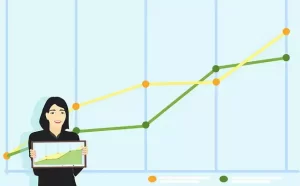The technique of optimising websites, such as eCommerce platforms, to rank higher on search engine results pages, or SERPs, to attract more customers is known as search engine optimisation or SEO. In layman’s terms, SEO aims to increase the number of people who visit a website or increase traffic by achieving higher search engine results. It also allows you to grow your company and develop a strong presence in the internet community. The term “organic traffic” refers to traffic you do not have to pay for. Instead, send search engine users to your website using other channels such as social media, newsletters, and so on to generate free website traffic. Organic search traffic is growing in popularity.
How To Increase Website Traffic Through Google?
Initially Perform Keyword Research.
Always include relevant keywords in your text. Keywords must be utilised organically in text rather than pushed into it to the point where they distract the reader or detract from the core theme. Keywords should be utilised in the meta description, page title, URL, headers, and different places throughout the text.
Publish Guest Posts
Guest posting on other people’s websites is a wonderful way to build backlinks, increase referral traffic, and improve your SERP rankings. Before pitching a website in your field, make sure you’ve done your research.
To begin, look at a website’s content to see if it’s of high quality, as well as its domain authority and guest blogging policies. Also, find out if the publication will share the article on social media and if you will be tagged in it.
Increase Website Traffic by Using Advertising
Paid search, social media, and display ads are viable options for attracting traffic to your website. Users can disable display advertising. For example, thus each strategy has pros and cons. Because the average cost per click for Google Ads on the search network is between $1 and $2, it’s vital to set budgets and targets before investing.
Make A Resource For The Industry Or A Piece Of Information.
Giving potential consumers something valuable is a great way to get more people to visit your website. At our content marketing agency, we created a free editorial calendar template that anyone may use. We wanted to give marketers a platform to make it easier to develop and distribute content.
How To Increase Website Traffic SEO?

Create a Professionally Designed Website
You should consider building a sitemap if your site is new, huge, or has a lot of multimedia material. This file provides search engines with the information they require to crawl quickly and index web pages, videos, and music. Google provides an excellent sitemap generator. The same may be said for Bing. A sitemap is required for your website to appear in Google News.
Concentrate on a Single Subject
Search engines direct users to the most reliable and accurate results. As a result, unless you’re an expert on a topic you’d like to research, your website’s content should reflect that. Do you wish to share your culinary masterpieces with the rest of the world? Your website’s focus should then be on food. For example, don’t mix pancake content with metalworking. After all, your website isn’t a multibillion-dollar corporation or a large news organisation that must cater to everyone’s requirements.
Consistently Produce High-Quality Content
Search engines prioritise fresh, dynamic content. Copying and pasting text from another website is not a good idea. As a result of this, search engines will penalise your website. Concentrate on original, high-quality content. In addition, whether in new information, art, or merchandise. Visitors desire a cause to come back to your site or share your material on social media sites like Facebook, Twitter, and Instagram. Search engine spiders are also keen to examine new material.
Make Eye-Catching Page Titles and Headlines
A page title and a headline are two ways to name the same online page comparable but different. The first is a keyword-focused title intended to appease the search engine gods, while the second is for website visitors.
Optimise Your Photographs
On the internet, graphics are how we colour inside the lines; colourful, clean visuals make a website welcoming. You can also use images to highlight the product or service you’re attempting to sell, as well as to break up large blocks of text and keep readers engaged. You should spend time optimising photographs because they are so important.
Process Documentation and Streamlining
The purpose of an editorial calendar and content writing rules is to help you standardise the content generation process. So that each writer with whom you interact is aware of your expectations and creates new works that satisfy all of them. These two assets serve as the foundation for a defined content marketing process — a strategy for developing, updating, publishing, and sharing systemised and repeatable material.
Create a YouTube Channel
YouTube’s popularity continues to grow year after year. People on the site watched over one billion video hours per day in 2020. Create a YouTube channel and send some views to your website to capitalise on that massive viewing habit.
How to Enhance Organic Website Traffic?

Organic search accounts for 51% of all web traffic and 40% revenue. As a result, search marketing teams are continuously working to improve search traffic. Rank on page one of a search engine for a keyword, and you’ll see an increase in organic traffic; rank in the top three positions or the featured snippet for that keyword, and you’ll likely see an exponential increase in traffic. Identify and Repair Non-Performing Content: Non-performing content does not assist a site in meeting its marketing objectives—typically, driving organic traffic, conversions, or referrals from other sites. It’s not helping you and may even harm your chances of getting search traffic. Find New Keyword Opportunities. Even the most effective keyword strategy will most likely have gaps. It’s only natural: New, relevant keywords emerge regularly, and the addition of new product features creates new keyword opportunities. It takes time for content creators to incorporate those opportunities into their keyword strategy.
Optimise for A Higher Click-Through Rate
Positioning on page one is only half the battle for organic search traffic; you must also persuade searchers to click on your result rather than a competitor’s. Blogging is one of the quickest ways to increase the number of keywords your site ranks for, particularly non-branded keywords. With top-of-funnel informational posts, blog posts allow you to position your brand as an expert in your field while also showcasing your product to people searching for related information.
The three essential components of a well-optimised web page or blog post are the urls, the description, and the keywords. It’s straightforward but effective. While all on-page SEO factors are important, meta descriptions and metadata allow you to tell Google exactly what you’re talking about. Write and publish as frequently as possible, but never at the expense of quality. More the high-quality content you have on your website or blog, such as thought leadership articles and blog entries, the more possibilities you generate for organic visitors to arrive. Once you’ve amassed a substantial library of information, you may link to it in blogs and on your website, directing readers to more related stuff.
Google prioritises sites with many incoming connections, particularly those from reputable sources. Clients, friends, family, partners, suppliers, industry experts, and other bloggers should be encouraged to link with your site. The more incoming connections your site receives, the higher it will rank since, simply put, the more authoritative it seems to search engines. Be wary of SEO snake oil sellers that try to fool Google by employing spammy links from low-reputation sites. Some links are detrimental to your SEO.
How to Generate Organic Traffic to a Shopping Website?
Ecommerce website traffic is required regardless of what you wish to offer online. To sell continually online, you must have a steady stream of visitors to your website to nurture and convert into customers. Finding and optimising the right keywords is important in increasing organic traffic. These are the key phrases your target audience will use to find your company. As a result, if you want to rank higher, you should use well-researched and optimised ones.
Paid traffic is often generated by individuals clicking on an advertisement they saw on Google or social media. On the other hand, organic traffic comes from content that identifies you as an expert and improves the value of your website. The purpose of organic traffic is to solve your target audience’s concerns so that they will visit your website. The best aspect is that organic marketing strategies have long-term viability, unlike bought advertisements.
SEO (search engine optimisation) can assist your items or blog articles rank higher on search engine results pages (SERPs). To locate the terms, you need to target, use a reputable keyword research tool. Make a point of concentrating on buyer intent, transactional keywords, and those with a high search volume but low competition. After you’ve finished your study, add unique content to your product pages and blog, focusing on the keywords you’ve picked. Describe each product or service in-depth, including features, FAQs, comparisons, and so on.
How to Drive Organic Traffic to an Ecommerce Website?
Optimising your product description pages can thus improve traffic to your eCommerce website and drive conversions. You can reach a large portion of your target audience through social media and persuade them to buy your products and services. Incorporating it into your overall marketing strategy will help you not only attract visitors to your website & create strong relationships with your target demographic. The vast majority of consumers prefer that brands contact them via email.
As a result, an email is a potent tool for driving traffic to eCommerce websites by developing a landing page to collect email addresses from visitors to your site. Give them a lead magnet, such as a discount or a free resource in exchange for their email. Using a lead generation platform like Poptin to create email opt-in forms in other locations, such as the header, pop-ups, the about us page, etc., email list, segment it based on audience interests, funnel position, browsing behaviour, purchase behaviour, and so on.
You can then send content that is relevant to each segment. Because an eCommerce store serves a certain location, it is critical to optimise local SEO. This will allow you to reach out to everyone in that area. Local SEO optimisation allows you to rank where clients look for items or services in their area for local searches.
How To Increase Website Traffic Without A Lot of Money?

One of the most successful ways to increase visitors to your website is to use social media networks to promote your content. Twitter is perfect for quick, snappy (and tempting) connections, whereas Google+ advertising can help your site appear in tailored search results and appears to be particularly beneficial in B2B categories.
Make a Schedule Social Media Marketing Strategy
Social media is a must-have tool for online marketers. You can also use its power for free. This, however, varies according to demographics. So, focus on the two or three social media platforms that are the most popular with your fans and disregard the others. You should frequently write to retain your current followers and attract new ones. And avoid overloading readers with too many posts, though. It might be tough to strike the appropriate balance.
Use Influencer Marketing to Reach a Larger Number of People
Influencer marketing, in addition to social media marketing, influencer marketing can help you reach a broader audience. This is the technique of contacting influential people and asking them to promote you in a post. This might include a mention in an Instagram post or sharing one of your posts. Influencer marketing allows you to tap into someone else’s larger fan base. However, you should avoid contacting persons who have a large following. It should be proportional to your present level of achievement. Increase Search Results by
Using Search Engine Optimization
Does your name appear in the search results when you search for “your kind of music” and “your city”, does your name appear in the search results? Depending on your location, you may not make it to the first page or two of Google search results. For example, in Los Angeles, it would be tough to reach the summit. However, you should aim to improve your search ranks in smaller areas. Search engine optimisation (SEO) is the practice of making your website simpler to read for search engines by including specified keywords. Basic SEO begins with a website that works on all devices, such as a responsive design.
Create Backlinks

Backlinks are one of the most important components of good search engine optimisation. They are essentially links that lead directly to your website. Search engines give more credit to websites that have a significant number of high-quality links pointing to them. Inbound links to your site should provide high-quality material directly relevant to your own. Choose carefully which backlinks point to your site. Backlink your other content to your websites, such as blogs, articles, forums, and social networking. Writing in niche forums and guest blogging are two more excellent ways to increase backlinks. You may also answer questions about your niche on sites like Yahoo! Answers and then link back to your site for extra information.
Bookmarking on Social Media
Website traffic can be increased by using Digg, Reddit, Stumbleupon, and Twitter sites. Sign up for each site, and users will discover you in a library of links. In addition, if people discover your site, they can bookmark it at the top of your page and return whenever they want. This also helps them to spread the word about your website.
Create Excellent Material
The most vital aspect of every website is a large amount of high-quality content. You want to get users to your website and keep them there. So, don’t squander your visitors’ time with fluff. Teach them about your speciality, what distinguishes your product or service, and offer them a reason to return. Your audience should be educated, inspired, and entertained. Keep your content up to date. Increase user traffic back to your website by modifying and upgrading it regularly. This does not imply that you must give it a makeover every week. Adding new information, articles, news releases, images, and videos will encourage users to return more frequently.

